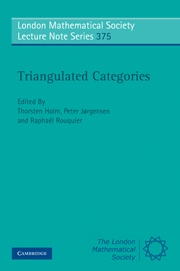Book contents
- Frontmatter
- Contents
- Preface
- Triangulated categories: definitions, properties, and examples
- Cohomology over complete intersections via exterior algebras
- Cluster algebras, quiver representations and triangulated categories
- Localization theory for triangulated categories
- Homological algebra in bivariant K-theory and other triangulated categories. I
- Derived categories and Grothendieck duality
- Derived categories and algebraic geometry
- Triangulated categories for the analysts
- Algebraic versus topological triangulated categories
- Derived categories of coherent sheaves on algebraic varieties
- Rigid dualizing complexes via differential graded algebras (survey)
Derived categories of coherent sheaves on algebraic varieties
Published online by Cambridge University Press: 07 September 2011
- Frontmatter
- Contents
- Preface
- Triangulated categories: definitions, properties, and examples
- Cohomology over complete intersections via exterior algebras
- Cluster algebras, quiver representations and triangulated categories
- Localization theory for triangulated categories
- Homological algebra in bivariant K-theory and other triangulated categories. I
- Derived categories and Grothendieck duality
- Derived categories and algebraic geometry
- Triangulated categories for the analysts
- Algebraic versus topological triangulated categories
- Derived categories of coherent sheaves on algebraic varieties
- Rigid dualizing complexes via differential graded algebras (survey)
Summary
Abstract. In this article, we give the introduction of the recent developments on the derived categories of coherent sheaves on algebraic varieties. We also introduce the notion of stability conditions on triangulated categories in the sense of T. Bridgeland.
Introduction
The notion of derived category of coherent sheaves was first introduced in [24] in order to formulate the Grothendieck duality theorem. It is a category whose objects are complexes of coherent sheaves, and has a structure of a triangulated category. Recently it has been observed that the derived category represents several interesting symmetries, which seems impossible without the notion of derived categories, e.g. McKay correspondence [16], Homological mirror symmetry [43], etc. Now derived categories are a very popular area with interactions with many other subjects including non-commutative algebra, birational geometry, symplectic geometry and string theory. In this article, we give an introduction of the recent results on these topics.
The content of this article is as follows. In Section 2, we give the basic notions concerning derived categories, and propose some fundamental problems. In Section 3, we discuss the relationship between derived category and birational geometry. In Section 4, we discuss the symmetries between derived categories of coherent sheaves and that of module categories of some non-commutative algebras. In Section 5, we introduce the notion of stability conditions on triangulated categories, defined by T. Bridgeland, and see how this notion explains the several symmetries we discuss in this article.
- Type
- Chapter
- Information
- Triangulated Categories , pp. 408 - 451Publisher: Cambridge University PressPrint publication year: 2010

